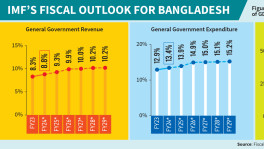Covid-19 has affected two-thirds of families: BBS
Both their income and spending dropped in the April-July period during the pandemic

More than two-thirds of families were financially affected by the novel coronavirus pandemic in the April-July period as both their income and expenditure dropped while the rate of unemployment in that time surged manifold.
"Family-level income reduced 20.25% on average while spending dropped 8.34% in March-August. Unemployment went up by at least ten times from 2.3% during the time," read a survey of the Bangladesh Bureau of Statistics (BBS).
The key findings of the BBS rapid survey were presented at the Executive Committee of the National Economic Council (Ecnec) meeting Tuesday.
The report said the country's economy, especially labour and employment, has bounced back offsetting the virus fallout. It claimed jobs in the agriculture and commerce sectors had already been retrieved by September, which dragged the unemployment rate to 4%.
According to the BBS, though the rate of joblessness has reduced, it is still 74% higher than usual.
The BBS prepared the report based on telephone interviews with 2,040 subscribers of the country's four mobile network operators. Just 48.48% of them gave information to the BBS.
The report said the average income of each family was Tk19,425 before the virus outbreak in Bangladesh in March. It declined to Tk15,492 in August – which means family-level income shrank by Tk3,933, or 20.25%, on average.
At the same time, per family average spending decreased from Tk15,403 to Tk14,119. Average household expenditure decreased by 8.34%.
Although income decreased at a higher rate, the drop in spending was lower compared to that.
The report said 68.39% families were financially affected by the pandemic in the April-July period. However, 21.33% of them received relief or other forms of aid from the government.
The BBS says though the government cash support programme targeted the marginalised people, the average income of the beneficiary household is below Tk20,000.
Eight percent of the survey participants said they used to work as day labourers in March and half of them remained jobless in July. Currently, 7.5% of the day wage earners are working again.
The survey said 10% of survey participants were involved in agriculture and none of them lost their jobs in the pandemic.
In the meantime, 17% of the survey participants said they were in businesses in March while the rate decreased to 10% in July. At present, all of them are back at their respective businesses.
According to the BBS, 2.3% of the survey participants were jobless in March while the unemployment rate jumped to 22.39% in July. According to this estimation, the unemployment rate rose 10 times in July, but 4% percent of the respondents claimed to be unemployed in September.


 Keep updated, follow The Business Standard's Google news channel
Keep updated, follow The Business Standard's Google news channel
















